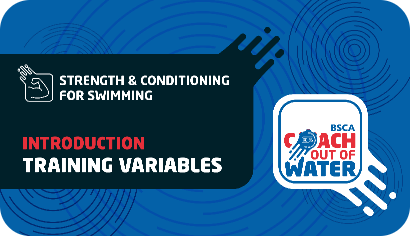Strength & Conditioning (S&C) is vital for swimmers looking to maximise performance, reduce injury risk, and complement water-based training. This programme has been created in line with BSCA guidance, ensuring it supports — not replaces — your club’s pool sessions.
Pete Yardley is a highly qualified Strength & Conditioning coach and personal fitness instructor with extensive experience in swimming. He has coached on Swim England camps at multiple levels, bringing specialist knowledge of how to support developing athletes. This programme combines his expertise with guidance from the British Swimming Coaches Association (BSCA).
With 3 videos already available — and more to come — this programme grows with you. Each session builds key movement patterns and strength skills that translate directly to improved swimming performance.
Swimmers
Build power, speed, and injury resilience.
Coaches
Supplement your athletes’ training with age-appropriate land work.
 This is the first in a new educational video series on dryland training for swimmers, and we’re starting by breaking movement down to its essentials.
In this session, I’ll walk you through six key patterns - squat, hinge, lunge, push, pull, and carry - with some bonus core work.
You’ll see how each of these translates into faster, more powerful, and more resilient athletes in the pool, while also building
transferable strength and fitness that benefits swimmers long after they leave the sport.
This is the first in a new educational video series on dryland training for swimmers, and we’re starting by breaking movement down to its essentials.
In this session, I’ll walk you through six key patterns - squat, hinge, lunge, push, pull, and carry - with some bonus core work.
You’ll see how each of these translates into faster, more powerful, and more resilient athletes in the pool, while also building
transferable strength and fitness that benefits swimmers long after they leave the sport.
 Here we explore the training variables that shape effective dryland programmes. These are the key levers coaches can pull to build strength,
power, endurance, and control. We cover 8 core variables: sets & reps, rest, tempo & time under tension, RIR/RPE, exercise selection,
frequency, exercise order, and training phase. By understanding how to manipulate these, you can keep sessions purposeful, safe,
and engaging, all while aligning them with the needs of your group. The art lies in knowing which variables to adjust, and when.
Here we explore the training variables that shape effective dryland programmes. These are the key levers coaches can pull to build strength,
power, endurance, and control. We cover 8 core variables: sets & reps, rest, tempo & time under tension, RIR/RPE, exercise selection,
frequency, exercise order, and training phase. By understanding how to manipulate these, you can keep sessions purposeful, safe,
and engaging, all while aligning them with the needs of your group. The art lies in knowing which variables to adjust, and when.
 In today’s session, we go beyond simply thinking about exercises and looked at the systems we use to
structure them. We explore a range of methods such as supersets, cluster sets, eccentrics, drop sets,
contrast training, and pyramids, and brake down when and why each can be used. The key takeaway is that
training systems add purpose, efficiency, and progression to dryland, helping you target specific adaptations,
keep swimmers engaged, and align your sessions with their age, ability and the point in the season.
By choosing the right system, you unlock far greater results from the same exercises.
In today’s session, we go beyond simply thinking about exercises and looked at the systems we use to
structure them. We explore a range of methods such as supersets, cluster sets, eccentrics, drop sets,
contrast training, and pyramids, and brake down when and why each can be used. The key takeaway is that
training systems add purpose, efficiency, and progression to dryland, helping you target specific adaptations,
keep swimmers engaged, and align your sessions with their age, ability and the point in the season.
By choosing the right system, you unlock far greater results from the same exercises.